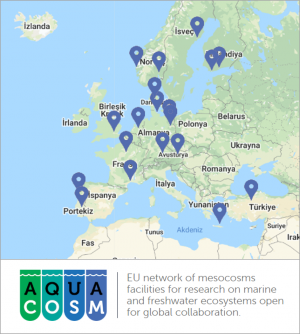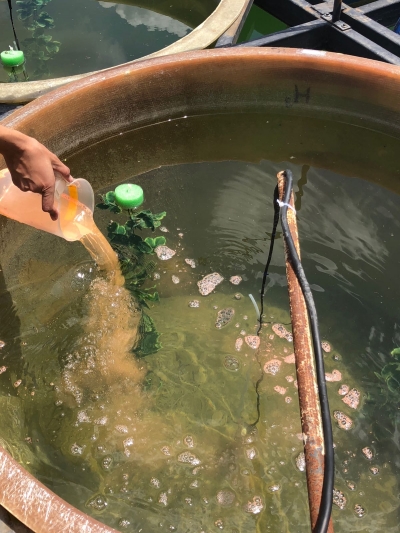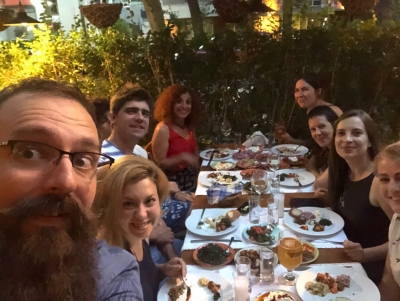AQUACOSM
AQUACOSM PROJECT
Project Information
Aquatic research is still divided in marine and freshwater sciences, with separate funding sources, and experimental science is often conducted at single sites without international coordination. To challenge these problems, the FvB-IGB-lead project AQUACOSM is funded by the first international call (EU H2020-INFRAIA) to coordinate research, develop common best practices and open both freshwater and marine large-scale research infrastructures (mesocosms) for international cross-discipline participation.
Project Title: EU H2020-INFRAIA-project No 731065 "AQUACOSM: Network of Leading European AQUAtic MesoCOSM Facilities Connecting Mountains to Oceans from the Arctic to the Mediterranean"
Duration: 01/2017-12/2020
Funded by: European Commission, Directorate-General for Research & Innovation, Budget 9,999,807 €
Direction: Dr. Jens Nejstgaard (Project leader), nejstgaard@igb-berlin.de, Dr. Stella Berger (Transnational Access leader), berger@igb-berlin.

Project partners: Aarhus University, AREFSENS Electronics Inc., Blue Lobster IT Ltd, Centro de Biodiversidade e Recursos Genéticos – Universidade de Évora, CNRS – MARine Biodiversity-Exploitation and Conservation, Ecole Normale Supérieure, Finnish Environment Institute-Marine Research Centre, Forschungsverbund Berlin e.V. – Leibniz-Institut für Gewässerökologie und Binnenfischerei, GEOMAR Helmholtz Centre for Ocean Research Kiel, Hellenic Centre for Marine Research, Imperial College of Science Technology and Medicine, Ludwig-Maximilians-Universität, Middle East Technical University, Netherlands Institute of Ecology, Norwegian Institute for Water Research, Umeå Marine Science Center, Umweltbundesamt, Uni Research AS, University of Bergen, University of Helsinki-Tvärminne Zoological Station, WasserCluster Lunz-Biologische Station GmbH
As a partner of AQUACOSM, METU MESOCOSM SYSTEM hosts researchers worldwide and together they conduct research on the impacts of climate change in freshwater ecosystem using METU Mesocosm System. For more information on the AQUACOSM project, please visit the project website at https://www.aquacosm.eu/.
AQUACOSM PROJECT 2019 EXPERIMENT:
Dissolved Organic Carbon(DOC)– Impacts of Pulsed DOC Disturbance in shallow freshwater lakes

Time and Location
The 2019 mesocosm experiment was conducted at METU Mesocosm System (aquatic) at METU Experimental Lake (Lake Golet) between 20 June – 26 July 2019.
Objective
The primary objective of the experiment is to investigate the responses of the system to dissolved organic carbon (DOC) pulses from terrestrial sources as a part of Joint mesocosm experiments of Aquacosm (JOMEX). Through the changes in precipitation pattern in the eastern Mediterranean lately, winter snow packs have been largely replaced with early and late spring heavy rains and intensive flush floods. Such conditions increase transport of matter from terrestrial environments into aquatic systems is a highly relevant aspect of global change even in Eastern Mediterranean in Turkey
Hypothesis
We investigated the response of different plankton communities to a pulsed DOC disturbance and followed the reaction of the system after this strong disturbance in terms of resistance, resilience and recovery (i.e. ecosystem stability concept). We hypothesized that 1) DOC will cause compositional and/or functional shifts in the communities following resistance, resilience, recovery stages, 2) the effects of these shifts will be transferred throughout the food web, 3) systems with high initial functional diversity will have a faster recovery towards initial conditions

Experimental Set-up
For this purpose, METU Mesocosm System at Lake Golet was used with 16 mesocosms with 4x4 design. In order to simulate the effects of terrestrial DOC, two different DOC source was tested: (i) Local DOC extracted from Local Alder Tree Leaves to test the nutrient effect of terrestrial DOC on freshwater systems (ii) Humin Feed (Humintech GmbH), which is a highly standardized product that is used to test light limitation effect of DOC on freshwater systems. Therefore, Mesocosm System included 16 mesocosms with 4 Controls, 4 replicates including a highly standardized DOC source (4 ppm HF) and 4 replicates including a local, more site-specific DOC source (8 ppm Local DOC) and 4 replicates including both sources (4 ppm HF and 8 ppm Local DOC).
With the aim of understanding whole-ecosystem responses, we investigated physiochemical parameters, microbial community structure (16S-18S rRNA), microbial loop community dynamics (bacteria, HNF, ciliates), phytoplankton and zooplankton community structure, lake metabolism and lake stoichiometry.
International Cooperation
We had TA Access teams with projects MicroMESO, PperDOC, ECMMETU2019 and AlloEcoMetry, comprising scientists from Greece, Turkey, Brazil, Croatia and Ireland.
Team MicroMESO:
Team Leader
Assist. Prof. Dr. Emmanuel (Manolis) LADOUKAKIS, Department of Biology, University of Crete, Greece
Team Members
Assoc. Prof. Dr. Efe Sezgin, Department of Food Engineering , Izmir Institute of Technology
PhD student Marilena Parakatselaki, Department of Biology, University of Crete, Greece
MSc student Hüseyin Yiğit Şahin, Ege University & Aegene Biotechnology Inc., Turkey
Team PperDOC
Team leader
Dr. Kemal Ali Ger, Universidade Federal do Rio Grande do Sul-UFRGS, Brazil
Team members
Prof. Dr. Maria Spoljar, Department of Biology, University of Zagreb, Croatia
Prof. Dr. Sanja Gottstein, Department of Biology, University of Zagreb, Croatia
MSc Student Claudia Fiorentin, Department of Biology, University of Zagreb, Croatia
Team ECMMETU2019
Team leader
Dr. Mikkel Rene Anderson, Dundalk Institute of Technology, Ireland
Team members
Research Assistant Pınar Kavak Gulbeyaz, Department of Environmental Engineering, Hacettepe University, Turkey
Prof. Dr. Nusret Karakaya, Department of Environmental Engineering, Bolu Abant Izzet Baysal University, Turkey
Team AlloEcoMetry
Team leader/member
PhD student Maria Caldero Pascual, Dundalk Institute of Technology, Ireland
AQUACOSM PROJECT 2018 EXPERIMENT:
MICROPLASTICS– Impacts of microplastics in shallow freshwater lakes

Time and Location
The 2018 mesocosm experiment was conducted at METU Mesocosm System (aquatic) at METU Experimental Lake (Lake Golet) between 18 June – 06 August 2018.
Objective
The primary objective of the experiment was to evaluate the effects of microplastics (MP) in shallow freshwater lakes by exposing surface, water column and sediment of mesocosms simultaneously to the environmentally relevant mixture of various microplastic polymers.
Hypothesis
The following hypothesis were tested in this 2018 mesocosm study (1) MPs found in the water column would stay long enough time be ingested by zooplankton and this ingestion would likely cause a reduction on zooplankton biomass especially in the high concentration; (2) MPs in the sediment would be ingested by the sediment dwelling community that would cause and observable effect of morphometry and emergence pattern; (3) MPs would be transferred between trophic levels through the ingestion of MPs by prey and predation.

Mesocosm Set-up
For this purpose, METU Mesocosm System at Lake Golet was used with 12 mesocosms with 3x4 factorial design. There were 4 tanks with Low MP Dose (L-MP) having environmentally realistic MP concentrations (0.007 g MP/m2 of surface water; 2 g MP/m3 for water column; and 8 g MP/m2 of sediment), 4 future scenario tanks with High MP Dose (H-MP) having 10x higher concentrations than L-MP, and 4 tanks with Control (C) having no MP additions. Based on the available freshwater literature on the composition of microplastics in various compartments, we exposed sediment layer with the following MP composition: 45% polyethylene; 20 % polystyrene; 15% poplypropylene; 10% polyamide; and 10 % polyvinylchloride. On the other hand, surface layer was exposed to 50% polyethylene; 40% poplypropylene; and 10% polystyrene. For the water column, we used fluorescently-labelled polyethylene (50% green polyethylene with 63-75 µm in diameter, 50% red polyethylene with 10-45 in diameter) to track ingestion and transfer of MP between trophic groups.
International Cooperation
We had 2 TA Access teams with projects MICROFREAK and EMPOWER, comprising scientists from Serbia, USA, Czech Republic and UK.

Team MICROFREAK:
Team Leader
Asst. Prof. Boris Jovanovic, Natural Resources Ecology and Management, Iowa State University, IA, USA
Team Members
PhD student Jelena Stankovic, Department of Biology and Ecology, Faculty of Sciences and Mathematics, University of Niš, Serbia
PhD student Dimitrija Savic Zdravkovic, Department of Biology and Ecology, Faculty of Sciences and Mathematics, University of Niš, Serbia
Asst. Prof. Djuradj Milosevic, Department of Biology and Ecology, Faculty of Sciences and Mathematics, University of Niš, Serbia
Team EMPOWER:
Team leader
Assoc. Prof. David Boukal, Department of Ecosystem Biology, University of South Bohemia, Czech Republic
Team members
Dr. Heidrun Feuchtmayr, Lake Ecosystems Group , UK Centre for Ecology & Hydrology-CEH, UK
PhD student Derya Öztürk, Aquatic Ecology Lab., Department of Ecosystem Biology, University of South Bohemia, Czech Republic
PhD student Lucie Vebrova, Aquatic Ecology Lab., Department of Ecosystem Biology, University of South Bohemia, Czech Republic
PhD student Jessica Richardson, Lake Ecosystems Group , UK Centre for Ecology & Hydrology-CEH, UK
